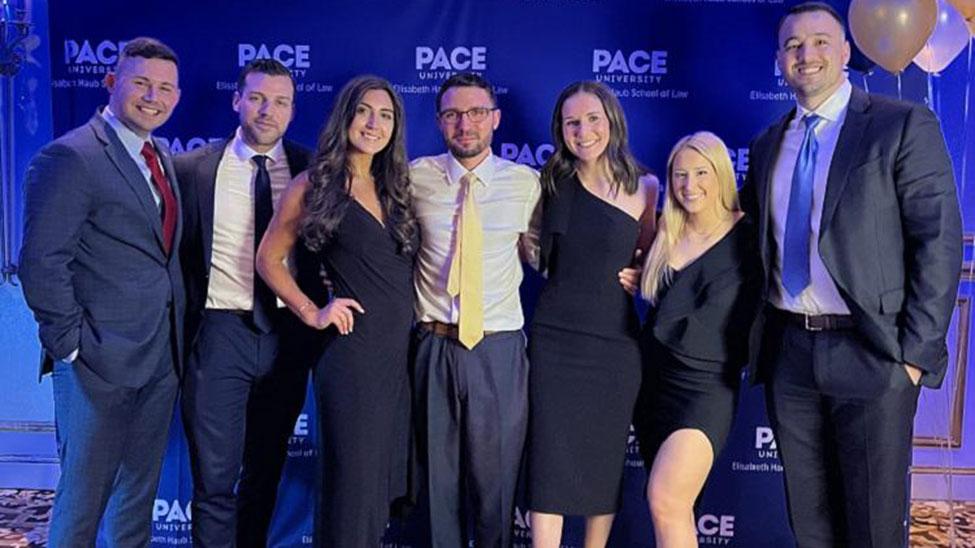
1906 Challenge
On April 27 and 28, for 1,906 minutes, Pace alumni, friends, parents, faculty, and staff will make their investment in the lives of Pace students through scholarships, financial aid, student aid, and professional growth. We're challenging YOU to help us make our $150,000 goal.
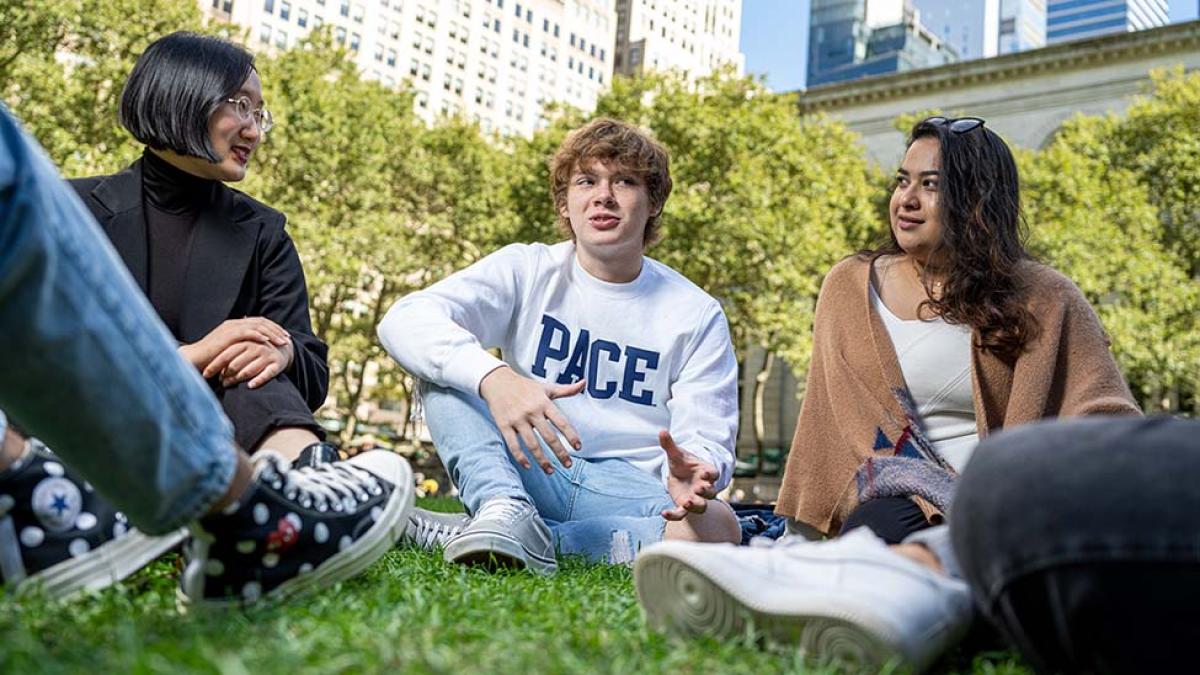
Haub Law team reaches semi-finals in American Association for Justice National Final Competition
Reigning National Finalists, Haub Law’s Trial Advocacy team was back at this year’s American Association for Justice (AAJ) National Final Competition for the second year in a row. From April 8–10, 2022, Haub Law faced off against the top 20 Regional Winners from across the country. The Haub Law team, consisting of Mattison Stewart (3L), Regina Rubino (3L), Kathryn Facelle (2L), and Michael McNally (2L), along with their trial technician Angelo Spedafino (3L), and their coaches AJ Muller, Esq. and Mike Luterzo, Esq., were ranked as the first seed in the preliminary rounds of the national competition as they embarked on another run for the National Championship.
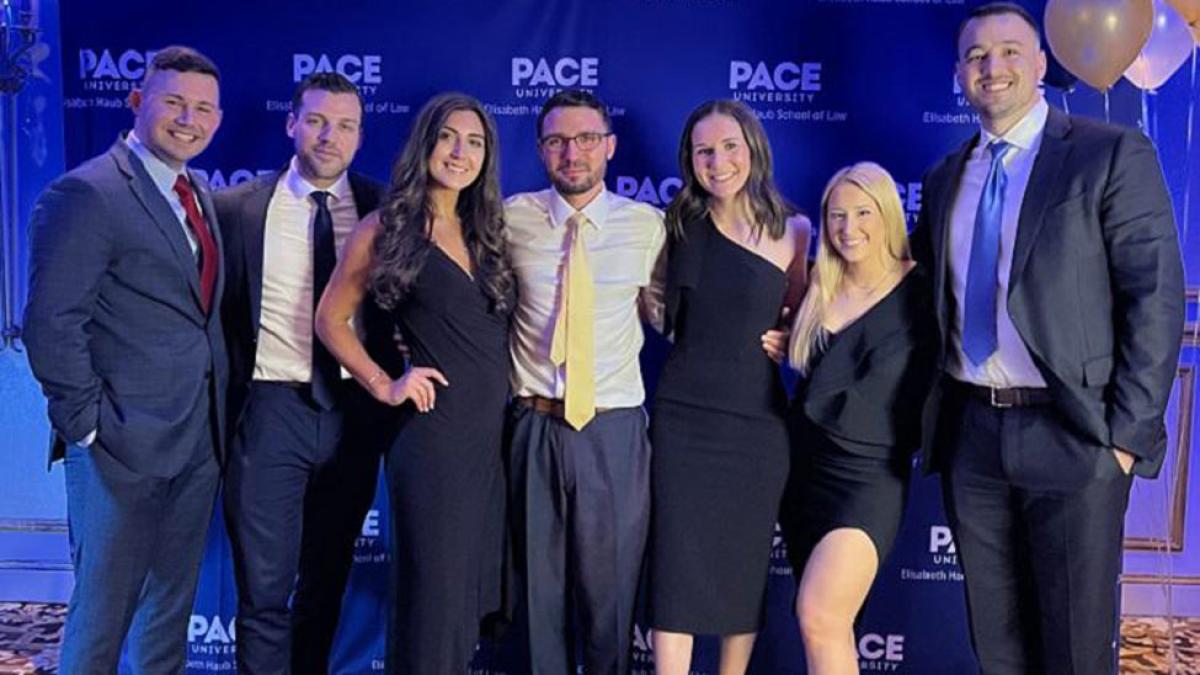

Reigning National Finalists, Haub Law’s Trial Advocacy team was back at this year’s American Association for Justice (AAJ) National Final Competition for the second year in a row. From April 8–10, 2022, Haub Law faced off against the top 20 Regional Winners from across the country. The Haub Law team, consisting of Mattison Stewart (3L), Regina Rubino (3L), Kathryn Facelle (2L), and Michael McNally (2L), along with their trial technician Angelo Spedafino (3L), and their coaches AJ Muller, Esq. and Mike Luterzo, Esq., were ranked as the first seed in the preliminary rounds of the national competition as they embarked on another run for the National Championship.
Ultimately, the Haub Law team advanced to the semi-finals, losing only to UCLA, the current and past champion, by a spilt decision with a tiebreaker deciding the round. The superstar team advanced to the National Finals after placing as Regional Champions just one month before out of a field of 160 competing teams from across the nation. This past fall, the team also advanced to the National Semi-Finals of the All-Star Bracket Challenge, placing in the Top 4 out of 64 of the nation’s top teams. Additionally, last spring, the team placed as National Finalists in the AAJ, ranking them 2nd out of 192 teams nationally.
“This is an outstanding group of dedicated and talented students. The 3Ls on this team have been AAJ Regional Champions in back-to-back years, advancing the National Final round (2021) and Semi-Final Round (2022), solidifying Pace’s reputation among the top trial advocacy program in the country,” said head coach and mentor, Adjunct Professor AJ Muller, Esq. “Adding to that yet another national advancement and successes in the Fall’s All-Star competition, this team has brought Pace’s Advocacy Program unquestionable national recognition and respect. This team graduates, Ms. Rubino and Ms. Stewart, accompanied by our outstanding technician, Mr. Spedafino, have done more than just put-up high scores and win trophies, they have taken the time to develop the 2L’s to foster a sustainable future of excellence for the Advocacy Program. This year’s victory was a true team effort with stellar performances all around. We expect to make another run at national victory next year with our outstanding 2L’s, Ms. Facelle and Mr. McNally, who will be a force to be reckoned with.”
Haub Law 3L, member of the winning mock trial team, and Executive Director Mattison Stewart stated, “I am so proud of our team that I have been fortunate enough to compete with. Every semester we put in countless hours practicing, scrimmaging, and meeting to perfect our sides of the case. We individually put in over 200 hours each because we all have a common goal: win. I have become a better student, advocate and person because of the Advocacy Program. I never thought I’d be lucky enough to be on competition teams since the beginning of my 2L year, no less make national runs for three semesters in a row. None of this would be possible without our coach AJ Muller, who truly puts in so much energy and time into making us better advocates, not only for mock trial but real life. Mike Luterzo has been an amazing addition to the coaching here too; his out-of-the-box thinking really helps us one-up the other teams. I wouldn’t have wanted to spend my last two years doing anything besides putting everything I have into the Advocacy Program and this team.”
The Elisabeth Haub School of Law’s impressive trial advocacy program once again ranked in the top 15% of law schools, coming in at number 26 this year. Over the last few years, Haub Law has had 28+ Mock Trial and Moot Court Teams, with an average of over 124 student participants on these teams as a whole. The Law School’s Mock Trial and Moot Court teams regularly place at or near the top in competitions. In the fall of 2021, Haub Law hosted its first Advocate in Residence, Gillian More, a lifelong prosecutor with a worldwide reputation in advocacy. Haub Law’s trial advocacy program is led by Lou Fasulo, Director of Advocacy, Moot Court and Client Counseling programs.
“This result shows the quality of our students, the dedication of our coaches and the commitment of our program to remain a leader in training advocates for the benefit of future clients. I will be watching our graduates as they accomplish even greater successes in their career,” said Haub Law’s Director of Advocacy, Lou Fasulo.
Westchester County Honors Pace Energy and Climate Center and Partner WCA with ECO Award
On Earth Day, the Elisabeth Haub School of Law at Pace University’s Energy and Climate Center and its partner the Westchester County Association (WCA), were honored for their work developing a Clean Energy Program Portal at the 3rd annual Westchester County ECO Awards. The awards ceremony was hosted by Westchester County Executive George Latimer and Westchester County’s Department of Environmental Facilities at Glen Island Park in New Rochelle to recognize outstanding contributions to the environment and sustainability made by residents, students, schools, municipalities, businesses, and other organizations throughout the county.
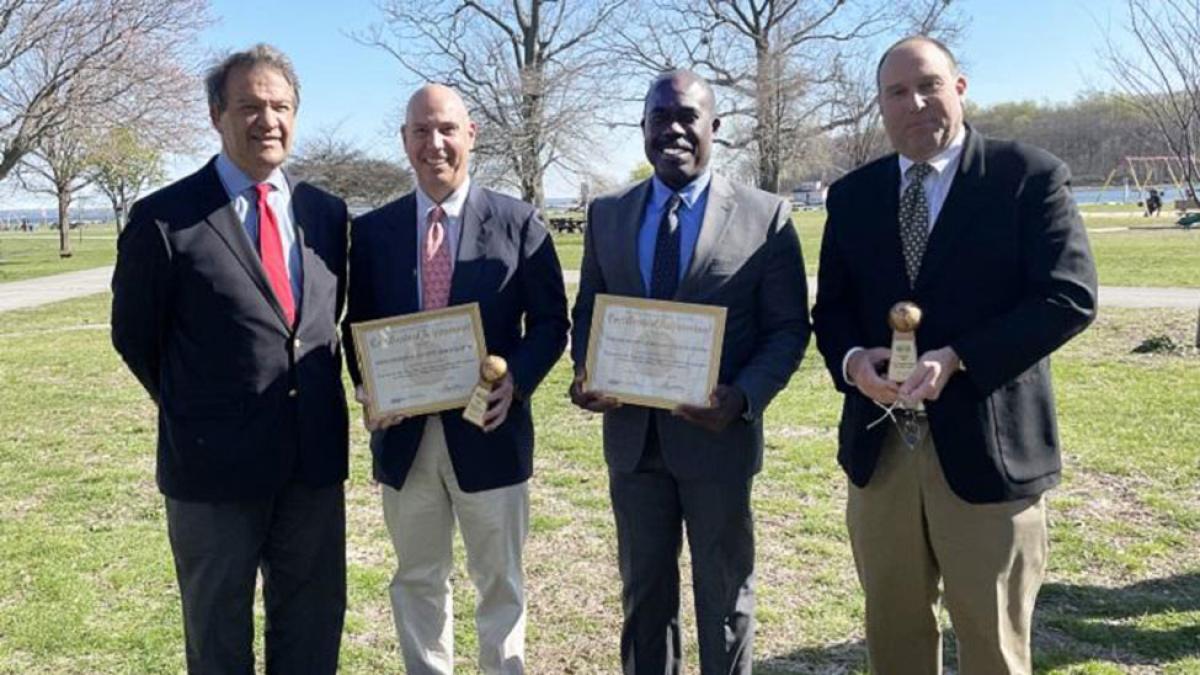
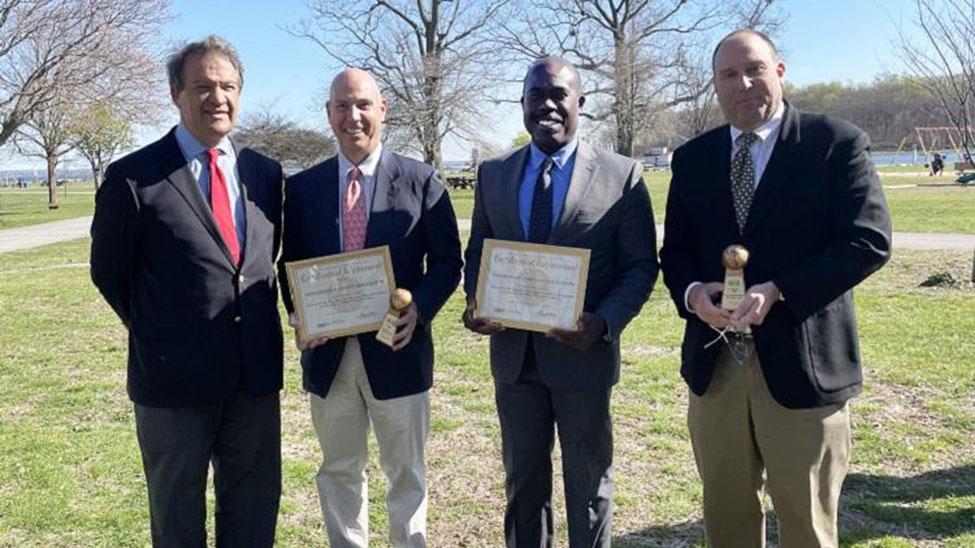
On Earth Day, the Elisabeth Haub School of Law at Pace University’s Energy and Climate Center and its partner the Westchester County Association (WCA), were honored for their work developing a Clean Energy Program Portal at the 3rd annual Westchester County ECO Awards. The awards ceremony was hosted by Westchester County Executive George Latimer and Westchester County’s Department of Environmental Facilities at Glen Island Park in New Rochelle to recognize outstanding contributions to the environment and sustainability made by residents, students, schools, municipalities, businesses, and other organizations throughout the county.
The Clean Energy Program Portal is a dynamic searchable guide to clean energy incentives, tools and technical support for businesses in Westchester and the surrounding region. Pace and WCA developed the portal to support the local business community in embracing sustainable business practices in the Westchester County and beyond.
“While the Center works on a broad range of initiatives internationally, nationally and state-wide, there is no more important work than our work in our own community,” said Craig Hart, Executive Director of the Pace Energy and Climate Center who accepted the award along with Michael Romero, President and CEO of the WCA, and Horace E. Anderson, Jr, Dean of the Elisabeth Haub School of Law. “Our collaboration with the Westchester County Association is important to our encouraging greater sustainability among the business community in Westchester.”
Along with the Pace Energy and Climate Center and the WCA, Westchester County recognized several other non-profit organizations and volunteers whose innovation and support to municipalities has helped the county remain a leader in its sustainability efforts compared to many other counties, states, and regions.
PaceU and Assemblymember Abinanti Discuss Neurodiverse Students
Pace University on Wednesday hosted Assemblymember Tom Abinanti for a discussion about ways of educating and preparing neurodiverse students for life during and after college.
89th Haggerty Awards held at Metropolitan Basketball Association Dinner in Tarrytown
- Read more about 89th Haggerty Awards held at Metropolitan Basketball Association Dinner in Tarrytown
It was a big night for Pace University centers, coach Kerry Seymour, one record 7th coach of the Year award and her centers reaching the NCAA Tournament Elite.
We’re kicking off our Earth Day 2022 extravaganza!
More than 60 plus Pace University students showed up this morning at the TODAY show. Here’s some easy things you can do to take better care of our planet.
We just set the Guinness World Record for the most people watering plants simultaneously in multiple venues!
We did it! Pace University students help break an Earth Day-themed Guinness Book World Record.
These Christian leaders embraced sex positivity — and now preach it
And in a survey that year of 133 Christian college students across the United States, Aditi Paul, an assistant professor of communication studies at Pace University, found that 80 percent of Christian students masturbate, 68 percent watch pornography and 60 percent have had between one and six casual hookup partners.
War crime prosecutions in the Russia-Ukraine war: What to expect
Professor Alexander K. A. Greenawalt provides expert insight on the feasibility of war crime prosecutions in the Russian-Ukraine war in an article by PolitiFact.
Mayor Eric Adams to Address Pace University Commencement
Pace to hold the largest Commencement ceremony in University’s history to celebrate classes of 2020, 2021 and 2022. This is Pace's first in-person Commencement in three years, to be held on May 16, at the USTA Billie Jean King National Tennis Center.

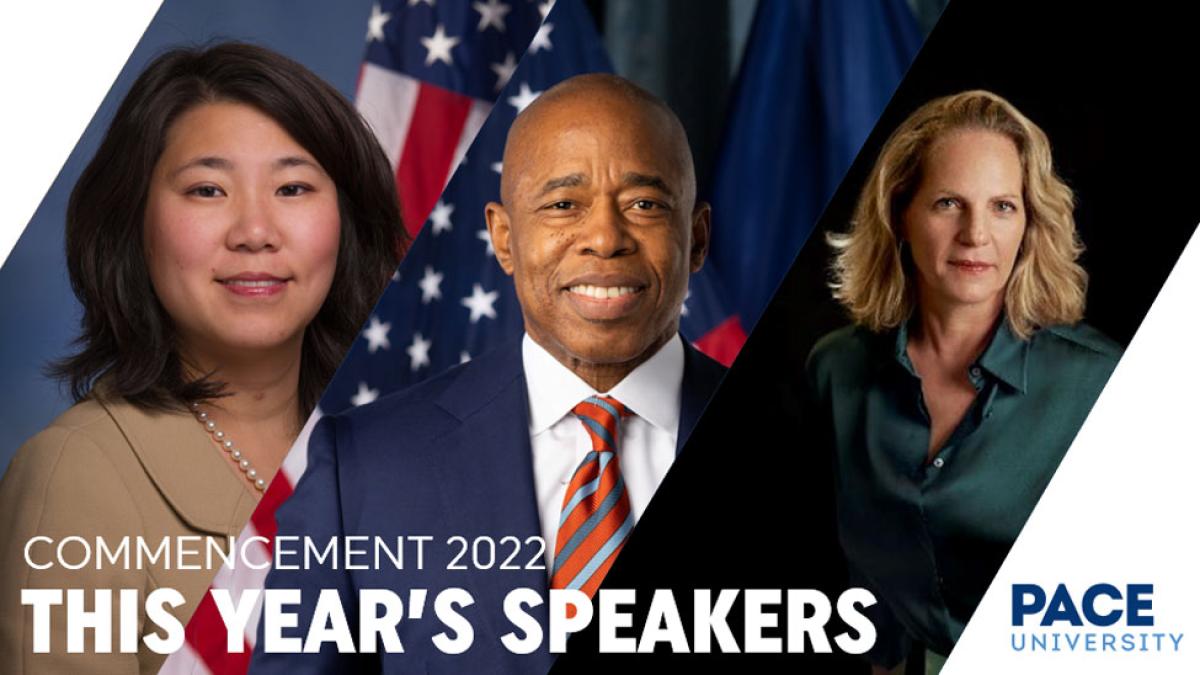
NEW YORK (April 25, 2022) – Mayor Eric Adams will address Pace University’s Commencement and will receive an honorary doctorate, Pace University President Marvin Krislov announced today. U.S. Rep. Grace Meng and finance and philanthropy leader Baroness Ariane de Rothschild, a Pace alumna, will also be recognized at the University’s first in-person Commencement in three years, to be held on May 16, at the USTA Billie Jean King National Tennis Center in Queens.
For the first time, Pace will hold a combined ceremony for graduates of its campuses in New York City and Pleasantville and from its Elisabeth Haub School of Law in White Plains. Classes of 2020 and 2021, who were not able to have a traditional celebration due to pandemic-related restrictions, will participate in what will be the largest ceremony in the history of the University.
“This will be the biggest and best commencement in Pace University’s history, and a fitting celebration for three extraordinary classes of Pace graduates,” said Marvin Krislov, president of Pace University. “The classes of 2020, 2021, and 2022 completed their degrees despite unprecedented challenges, and I couldn’t be prouder of their resilience, perseverance, and accomplishments.”
Mayor Adams will receive a Doctor of Humane Letters, honoris causa, degree at the 10:15 a.m. main Commencement ceremony, and he will address the graduates and their guests. Baroness Ariane de Rothschild '88 MBA '90, will also receive a Doctor of Humane Letters degree, honoris causa, and later in the day she will address graduates of the Lubin School of Business, from which she graduated, in their afternoon ceremony. Baroness de Rothschild is an accomplished financier, a successful entrepreneur, and a committed philanthropist. She has been president of the board of the Geneva-based Edmond de Rothschild Group since April 2019 and is the first woman to run a Rothschild financial institution.
Congresswoman Grace Meng will receive a Doctor of Laws, honoris causa, degree at the afternoon ceremony for the Elisabeth Haub School of Law. Rep. Meng is serving her fifth term in the U.S. House of Representatives and represents the borough of Queens in the Sixth Congressional District of New York. She is the first and only Asian-American member of Congress from New York State and the first female Congress member from Queens since former Vice Presidential nominee Geraldine Ferraro.
Opportunitas in Action Award Winners
At Commencement each year Pace honors members of the New York City and Westchester communities who exemplify the Pace motto of Opportunitas.
Marco Damiani, CEO of AHRC NYC, is the 2022 recipient of the Opportunitas in Action Award for New York City. Damiani leads the largest organization in New York—and among the largest in the country—dedicated to supporting people who are neurodiverse and helping them to lead full and equitable lives. Through its work, AHRC spreads its vision of a socially just world, where the power of difference is embraced, valued, and celebrated.
Joseph Kenner, CEO of Greyston, is the 2022 recipient of the Opportunitas in Action Award for Westchester. At Greyston, Kenner leads a pioneering organization that unlocks the power of human potential through Open Hiring—a hiring process that is open to anyone who wants to work, without background checks, resumes, or interviews. Over 40 years at its world-renowned Greyston Bakery—which makes the brownies included in Ben & Jerry’s products and packaged brownies for Whole Foods Market—Kenner’s organization has offered jobs to hundreds of people who otherwise faced obstacles to employment.
About Pace University
Since 1906, Pace University has educated thinking professionals by providing high quality education for the professions on a firm base of liberal learning amid the advantages of the New York metropolitan area. A private university, Pace has campuses in New York City and Westchester County, New York, enrolling nearly 13,000 students in bachelor’s, master’s, and doctoral programs in its Dyson College of Arts and Sciences, Lubin School of Business, College of Health Professions, School of Education, the Elisabeth Haub School of Law, and Seidenberg School of Computer Science and Information Systems.